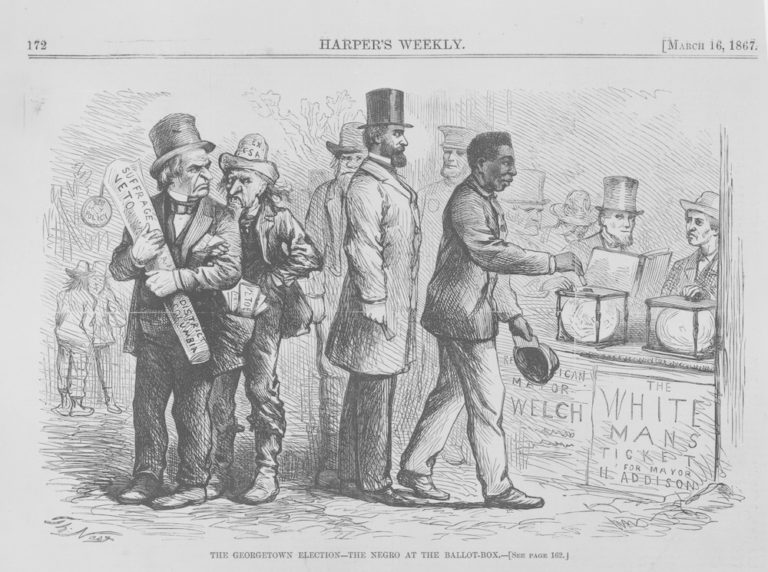The Technology of Democracy

The material history of the U.S. ballot
Check one:
Americans vote by secret ballot: Yes No
Voting is a private act: Yes No
If you answered yes to both questions, your response would reflect the Wikipedia entry for voting booth. But I was interested to discover that my early September Google search on “privacy of the voting booth” ranked the Wikipedia definition at number five. The ahistorical, low-tech definition is elbowed out by references to the technology of voting privacy: four companies offer their catalogs of products and accessories for election officers.
The technology of voting is at the heart of essays by Patricia Crain, Lisa Gitelman, and Laura Rigal. Their thoughts on this subject were prompted by questions posed by the notorious hanging chads of November 2000. But eight years later, they remain intensely relevant. The nature and function of the ballot, the ballot box, and the voting process, these papers make clear, have been contested matters for a very long time.
The disputed result of the 2000 election brought questions of materiality and meaning, which are frequently studied in academic settings, to the streets and the courts. The eerie notion of the weight that could be sustained by the seemingly fragile hanging chad found strong and suggestive parallels in the historical record illuminated in the three papers that constitute this section of the Common-place special issue on politics.
Ever since these provocative papers were presented at the SHARP Conference in Williamsburg in July 2001, they have been seeking a venue that would ensure their publication at an election season. As the editor of a print publication that is much less nimble than Common-place, I was delighted when this journal’s editor and guest editor, Edward Gray and Jeff Pasley, offered a place for these fine essays.
The ballot is the focal point of each of these essays. Its paper, ink, and mise-en-page (layout)—its authorship, publication, and reception—each of these elements of the ballot conveys a message about its origins, intentions, and meaning. Along the way this object, which would seem to be fixed, offers many opportunities for human intervention and interpretation. Patricia Crain worked in the collection of paper ballots at the American Antiquarian Society (four boxes containing eleven folders of ballots from across Massachusetts for national, state, and local elections ranging from 1811 to 1888, when the party “ticket” was replaced by the secret ballot). In her discussion of twenty-seven of these ballots, she recreates the context for which the ballot was created. In few instances were they plain and unadorned; rather they have been preserved as examples of printed ephemera that reflect conscious choices of technology such as paper dimensions, brightly colored inks, and graphic elements. As Crain indicates, these choices allowed for a high level of political advertising to be embedded within the paper on which a vote would be cast. These graphic elements included references to the preservation of the Union (1860), a Union naval victory over the Confederacy (1864), and a last-ditch effort seeking home rule for the South in 1876 using candidate Samuel Tilden’s engraved signature.
Lisa Gitelman moves the story forward into the era of the voting machine, in particular, the 1980s era VotoMatic—the patented alternative to physically marking a ballot with a pencil. Activated by a voter who made a selection by punching a hole in a card, the results of the vote were tabulated by a sorting device and prepared for dissemination. Congress had a long history of skepticism about machines and voting, although those debates seemed to have receded into the mist by 2000 when the results in the Florida presidential balloting were so blurred that their interpretation fell to the courts.
Laura Rigal’s reading of George Caleb Bingham’s The County Election has particular resonance when read in conjunction with the essays by Crain and Gitelman. Although Bingham was responding to an election lost by a narrow margin, previous interpretations of this painting portrayed it as representing a golden age of voting. Not so. Rigal reads the painting as a statement by an artist who had been actively involved in Whig politics in the1840s, as painter of banners, speech-giver, and ultimately candidate. This unsuccessful foray into politics resulted in this painting—set in his hometown, Arrow Rock, Missouri—which captured the racial and social dynamics of a “paperless,” viva voce election. In contrast to the impression provided by The County Election, nearly half of the town’s one thousand residents were African American. The political and economic lives of the riverfront, commercial community depicted here and its base in Saline County has been richly documented in historical studies. Rigal’s reflections on the visual representation of the hot-button issues of a contested election and its subsequent recount collapse the distance between that election and those of our own day. One might have thought that such problems would have been swept away with the introduction of the secret ballot after 1888.
This article originally appeared in issue 9.1 (October, 2008).
Caroline F. Sloat is director of scholarly publications at the American Antiquarian Society and editor of the society’s journal, Proceedings of the American Antiquarian Society.